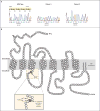Nephrogenic syndrome of inappropriate antidiuresis
- PMID: 15872203
- PMCID: PMC5340184
- DOI: 10.1056/NEJMoa042743
Nephrogenic syndrome of inappropriate antidiuresis
Abstract
The syndrome of inappropriate antidiuretic hormone secretion (SIADH) is a common cause of hyponatremia. We describe two infants whose clinical and laboratory evaluations were consistent with the presence of SIADH, yet who had undetectable arginine vasopressin (AVP) levels. We hypothesized that they had gain-of-function mutations in the V2 vasopressin receptor (V2R). DNA sequencing of each patient's V2R gene (AVPR2) identified missense mutations in both, with resultant changes in codon 137 from arginine to cysteine or leucine. These novel mutations cause constitutive activation of the receptor and are the likely cause of the patients' SIADH-like clinical picture, which we have termed "nephrogenic syndrome of inappropriate antidiuresis."
Copyright 2005 Massachusetts Medical Society.
Figures


Comment in
-
Hyperactive vasopressin receptors and disturbed water homeostasis.N Engl J Med. 2005 May 5;352(18):1847-50. doi: 10.1056/NEJMp058006. N Engl J Med. 2005. PMID: 15872199 No abstract available.
-
Nephrogenic syndrome of inappropriate antidiuresis.N Engl J Med. 2005 Aug 4;353(5):529-30; author reply 529-30. doi: 10.1056/NEJM200508043530520. N Engl J Med. 2005. PMID: 16079383 No abstract available.
-
Nephrogenic syndrome of inappropriate antidiuresis.N Engl J Med. 2005 Aug 4;353(5):529-30; author reply 529-30. N Engl J Med. 2005. PMID: 16080252 No abstract available.
References
-
- Robertson GL. Antidiuretic hormone: normal and disordered function. Endocrinol Metab Clin North Am. 2001;30:671–94. - PubMed
-
- Morello JP, Bichet DG. Nephrogenic diabetes insipidus. Annu Rev Physiol. 2001;63:607–30. - PubMed
-
- Bartter FC, Schwartz WB. The syndrome of inappropriate secretion of antidiuretic hormone. Am J Med. 1967;42:790–806. - PubMed
-
- Birnbaumer M, Gilbert S, Rosenthal W. An extracellular congenital nephrogenic diabetes insipidus mutation of the vasopressin receptor reduces cell surface expression, affinity for ligand, and coupling to the Gs/adenylyl cyclase system. Mol Endocrinol. 1994;8:886–94. - PubMed
Publication types
MeSH terms
Substances
Grants and funding
LinkOut - more resources
Full Text Sources
Other Literature Sources
Medical
Molecular Biology Databases
Miscellaneous
